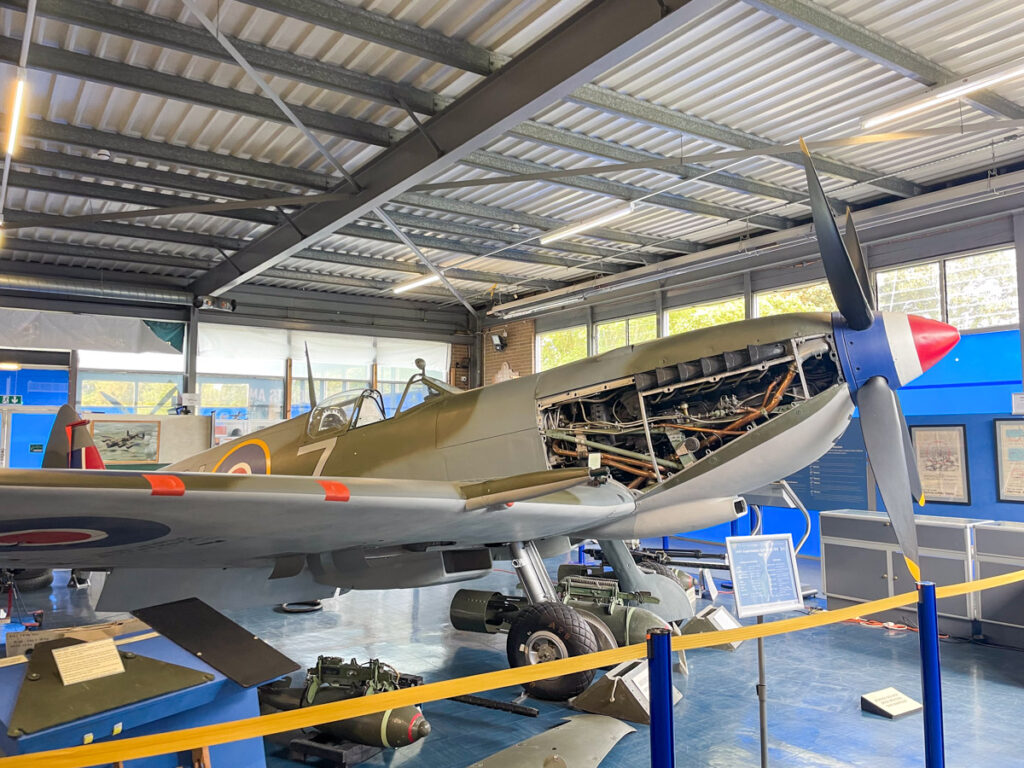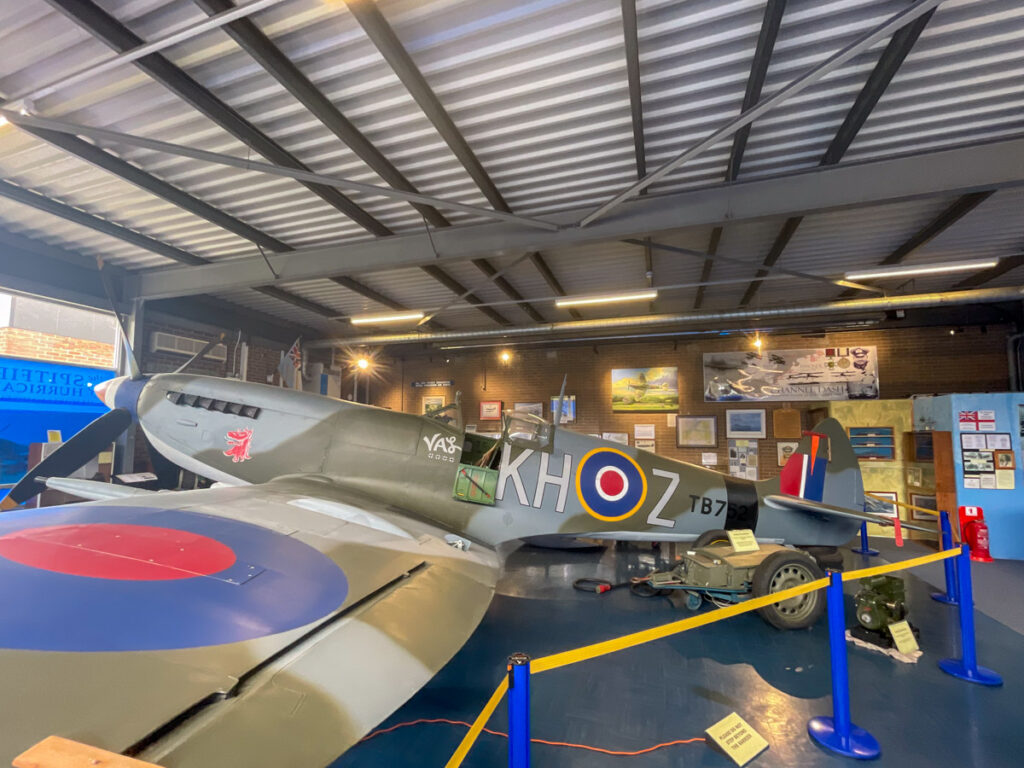The Spitfire & Hurricane Memorial Museum in Kent is an absolute must-visit destination for anyone passionate about aviation or interested in history. This small museum takes you on a journey through time, providing insights into the history of two of the most iconic aircraft of World War II: the Spitfire and the Hurricane.
Table of Contents
RAF Manston: A Journey Through History
RAF Manston airfield played an essential role in the UK’s defence for over a century as it was close to the continental coast. During the First World War, it was mainly used for emergency landings. Later, the Admiralty established an aerodrome at the site, which included the Handley Page bomber training school. Due to its location near the English Channel, Manston became an essential air defence station, especially after the formation of the Royal Flying Corps in 1917.
PLAN YOUR TRIP TO ENGLAND
Stay connected in England with a giffgaff free SIM or an Airalo eSim for seamless data coverage throughout the UK. Additionally, rent a car in the United Kingdom to explore all the attractions of the British countryside, including the fantastic museums on my blog!
During the Second World War, Manston was crucial in defending the UK, with No.3 Squadron flying Hawker Hurricanes from the airfield in 1939 under the command of No.11 Group Fighter Command. However, during the Battle of Britain in 1940, Manston suffered heavy bombing, forcing personnel and resources to be relocated to safer locations. Two years later, Manston was one of the departure points for the unsuccessful Operation Market Garden. The airfield served as an emergency landing field for returning bombers struggling with low fuel or hydraulic problems, becoming a graveyard for heavy bombers.
In the 1950s, the US Air Force used Manston as a Strategic Air Command base for its fighter and fighter-bomber units during the Cold War. The RAF regained control of the airfield in 1960, and its long runway built during the Second World War was designated a Master Emergency Diversion Airfield for both military and civilian flights.
In 1999, the RAF stopped flying operations, and Manston became exclusively used for civilian air traffic. Civilian operations ceased in 2014, and today, the airfield is limited to a small helicopter flight school.
Discover the Supermarine Spitfire
The Spitfire is undoubtedly one of the most famous planes in history, with its sleek design and impressive performance. The museum offers you the chance to explore the history of this remarkable aircraft, from its early development to its use in the Battle of Britain and beyond.
The Spitfire at the museum is one of the few that survived the war. Built in early 1944, it was part of the famous No. 66 Squadron at RAF Linton-on-Ouse in 1945. Armed with cannons and machine guns, it was used for attacks on roads and rail targets in Northern Holland and Germany.
In 1945, the Spitfire suffered significant damage when the port undercarriage leg failed to lower during landing, significantly damaging the wing and propeller blades. However, it was eventually repaired and continued to fly as a warplane. Today, you can learn about its complete history by visiting the museum.

The Hawker Hurricane: The Unsung Hero
While the Spitfire often steals the spotlight, the Hurricane played an equally important role in the Battle of Britain. The museum offers visitors a chance to learn about the development and history of this remarkable aircraft, which was instrumental in securing victory for the Allied forces.
The Hawker Hurricane is a famous UK fighter plane. The one on display was built in 1944 at Langley and first used by No. 1681 Bomber Defence Training Flight in the same year. Later on, it was moved to No. 27 Operational Training Unit at Waterbeach, where it remained in service for the rest of its operating life.
In 1945, the plane was repurposed for instructional use. However, to keep another Hurricane flying, many components were taken from it, along with two other Hurricanes on the station. Afterwards, it was refurbished for long-term external display.
Although it looked beautiful, the Hurricane’s steel and timber frame had suffered significant damage from exposure to the elements. After a detailed and lengthy damage assessment, the aircraft was repaired. Severe corrosion damage was fixed, and many replacement parts were handcrafted as closely as possible to the original specifications.
About 40% of the original aircraft, including propeller blades, cowlings, panels, timber, and fabric, had to be replaced or copied. It was a challenging task because almost no production drawings were available. Most of them were destroyed just after World War II.

Helpful Information to Visit Spitfire & Hurricane Memorial Museum
The Spitfire & Hurricane Memorial Museum has free admission. The museum is open every day except for Mondays from 10 am to 5 pm, although it is open on Bank Holiday Mondays.
In addition to the museum, the Spitfire Café located next to the entrance is open every day, from 8:30 am to 5:00 pm. We had breakfast there, waiting for the museum to open, and we enjoyed it.
Spitfire & Hurricane Memorial Museum with Kids
The museum is a great destination for families, with exhibits designed to engage visitors of all ages. My son is totally into aviation, and he liked the simulator for kids a lot, where he spent most of his time. You can also buy some metal war aircraft at the shop, perfect as a kid’s gift.
How to get to the Spitfire & Hurricane Memorial Museum
The Spitfire & Hurricane Memorial Museum is on the historic RAF airfield at Manston in Kent. The easiest way to reach the museum is by car. If you’re travelling from Dover, you can get to the museum in just half an hour via the A256. However, if you’re coming from London or Canterbury, follow the A299 to Ramsgate. To find the shortest route, you can enter the postcode CT12 5DF on your Sat Nav or Google Maps. There is plenty of free parking available at the museum.
Reaching the museum by public transport can be time-consuming and challenging. There is a local bus service operated by Stagecoach South East that stops near the museum, but I don’t recommend traveling by bus if you are not already in the area. For example, if you’re coming from Dover, it could take 2-3 hours during weekdays, with many changes, and even longer on weekends instead of just half an hour by car.
Spitfire & Hurricane Memorial Museum
Manston Rd, Manston
Ramsgate CT12 5DF
The Spitfire & Hurricane Memorial Museum in Kent is a small museum that provides a unique experience. It delves into the history of two of the most legendary aircraft of World War II. Feel free to share your thoughts in the comments section, regardless of whether you are already familiar with the Spitfire and the Hurricane aircraft.
